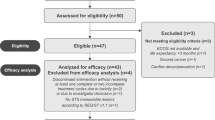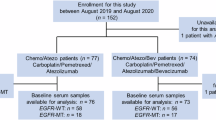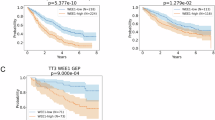Abstract
Angiogenesis has an important role in the pathogenesis and progression of multiple myeloma (MM). MM cells secrete vascular endothelial growth factor (VEGF), which further promotes proliferation of the tumor cells. Therefore, we evaluated the anti-myeloma effect of VEGF small interfering RNA (siRNA) silencing in MM cells and whether it can be augmented by the additional inhibition of the mammalian target of rapamycin (mTOR) by everolimus. We shown that everolimus inhibits cell growth of MM cells and other leukemic cells at low concentrations in a dose-dependent manner. After transfection with VEGF siRNA we observed a reduction of cell growth and VEGF expression in all studied cell lines: OPM-2, RPMI-8226, INA-6, JURKAT and RAJI. VEGF siRNA both significantly induced apoptosis and inhibited proliferation in OPM-2 cells (P<0.0001), RPMI-8226 (P<0.0001) and in INA-6 (P<0.01) versus controls. Co-treatment with VEGF siRNA and everolimus in MM cells resulted in an exaggerated inhibition of proliferation compared with VEGF siRNA or everolimus alone (P<0.0001) and enhanced induction of apoptosis compared with VEGF siRNA alone (P<0.03). In addition, the combination of VEGF siRNA and everolimus significantly reversed P-glycoprotein expression (P<0.005) and HIF-1α expression (P<0.001) of MM cells, respectively. Our data suggest that mTOR inhibition and silencing of VEGF expression is associated with synergistic antitumor activity and this combination treatment might be a suitable strategy for new therapeutic approaches using RNA interference in MM.
This is a preview of subscription content, access via your institution
Access options
Subscribe to this journal
Receive 12 print issues and online access
$259.00 per year
only $21.58 per issue
Buy this article
- Purchase on SpringerLink
- Instant access to full article PDF
Prices may be subject to local taxes which are calculated during checkout



Similar content being viewed by others
References
Dankbar B, Padro T, Leo R, Feldmann B, Kropff M, Mesters RM et al. Vascular endothelial growth factor and interleukin-6 in paracrine tumor-stromal cell interaction in multiple myeloma. Blood 2000; 95: 2630–2636.
Vacca A, Ribatti D, Presta M, Minischetti M, Iurlaro M, Ria R et al. Bone marrow neovascularization, plasma cell angiogenic potential, and matrix metalloproteinase-2 secretion parallel progression of human multiple myeloma. Blood 1999; 93: 3064–3073.
Podar K, Tai YT, Davies FE, Lentzsch S, Sattler M, Hideshima T et al. Vascular endothelial growth factor triggers signaling cascades mediating multiple myeloma cell growth and migration. Blood 2001; 98: 428–435.
Marković O, Marisavljević D, Cemerikić V, Vidović A, Perunicić M, Todorović M et al. Expression of VEGF and microvessel density in patients with multiple myeloma: clinical and prognostic significance. Med Oncol 2008; 25: 451–457.
Bazzi M, Badros A . Multiple myeloma: Implementing signaling pathways and molecular biology in clinical trials. Cancer Biol Ther 2010; 10: 830–838.
Oyama T, Ran S, Ishida T, Nadaf S, Kerr L, Carbone DP et al. Vascular endothelial growth factor affects dendritic cell maturation though the inhibition of nuclear factor-kappa B activation in hemopoietic progenitor cells. J Immunol 1998; 160: 1224–1232.
Gabrilovich DI, Chen HL, Girgis KR, Cunningham HT, Meny GM, Nadaf S et al. Production of vascular endothelial growth factor by human tumors inhibits the functional maturation of dendritic cells. Nat Med 1996; 2: 1096–1103.
Podar K, Catley LP, Tai YT, Shringarpure R, Carvalho P, Hayashi T et al. GW654652, the pan-inhibitor of VEGF receptors, blocks the growth and migration of multiple myeloma cells in bone marrow microenvironment. Blood 2004; 103: 3474–3479.
Koldehoff M, Beelen DW, Elmaagacli AH . Small-molecule inhibition of proteasome and silencing by vascular endothelial cell growth factor-specific siRNA induce additive antitumor activity in multiple myeloma. J Leukoc Biol 2008; 84: 561–576.
Ferrara N . Role of vascular endothelial growth factor in physiologic and pathologic angiogenesis: therapeutic implications. Semin Oncol 2002; 29: 10–14.
Carracedo A, Ma L, Teruya-Feldstein J, Rojo F, Salmena L, Alimonti A et al. Inhibition of mTORC1 leads to MAPK pathway activation through a PI3K-dependent feedback loop in human cancer. J Clin Invest 2008; 118: 3065–3074.
Récher C, Dos Santos C, Demur C, Payrastre B . mTOR, a new therapeutic target in acute myeloid leukemia. Cell Cycle 2005; 4: 1540–1549.
Panwalkar A, Verstovsek S, Giles FJ . Mammalian target of rapamycin inhibition as therapy for hematologic malignancies. Cancer 2004; 100: 657–666.
Saunders P, Cisterne A, Weiss J, Bradstock KF, Bendall LJ . The mammalian target of rapamycin inhibitor RAD001 (everolimus) synergizes with chemotherapeutic agents, ionizing radiation and proteasome inhibitors in pre-B acute lymphocytic leukemia. Haematologica 2011; 96: 69–77.
Haritunians T, Mori A, O'Kelly J, Luong QT, Giles FJ, Koeffler HP . Antiproliferative activity of RAD001 (everolimus) as a single agent and combined with other agents in mantle cell lymphoma. Leukemia 2007; 21: 333–339.
Fire A, Xu S, Montgomery MK, Kostas SA, Driver SE, Mello CC . Potent and specific genetic interference by double-stranded RNA in Caenorhabditis elegans. Nature 1998; 391: 806–811.
Novina CD, Sharp PA . The RNAi revolution. Nature 2004; 430: 161–164.
Elbashir SM, Harborth J, Lendeckel W, Yalcin A, Weber K, Tuschl T . Duplexes of 21-nucleotide RNAs mediate RNA interference in cultured mammalian cells. Nature 2001; 411: 494–498.
Elbashir SM, Lendeckel W, Tuschl T . RNA interference is mediated by 21- and 22- nucleotide RNAs. Genes Dev 2001; 15: 188–200.
Wilda M, Fuchs U, Wössmann W, Borkhardt A . Killing of leukemic cells with a BCR/ABL fusion gene by RNA interference (RNAi). Oncogene 2002; 21: 5716–5724.
Elmaagacli AH, Koldehoff M, Peceny R, Klein-Hitpass L, Ottinger H, Beelen DW et al. WT1 and BCR-ABL specific small interfering RNA have additive effects in the induction of apoptosis in leukemic cells. Haematologica 2005; 90: 326–334.
Koldehoff M, Steckel NK, Beelen DW, Elmaagacli AH . Synthetic small interfering RNAs reduce bcr-abl gene expression in leukaemic cells of de novo Philadelphia(+) acute myeloid leukaemia. Clin Exp Med 2006; 6: 45–47.
Takei Y, Kadomatsu K, Yuzawa Y, Matsuo S, Muramatsu T . A small interfering RNA targeting vascular endothelial growth factor as cancer therapeutics. Cancer Res 2004; 64: 3365–3370.
Elmaagacli AH, Freist A, Hahn M, Opalka B, Seeber S, Schaefer UW et al. Estimating the relapse in chronic myeloid leukaemia patients after allogeneic stem cell transplantation by the amount of bcr-abl fusion transcripts detected using a new real-time polymerase chain reaction methods. Br J Haematol 2001; 113: 1072–1075.
Dales JP, Beaufils N, Silvy M, Picard C, Pauly V, Pradel V et al. Hypoxia inducible factor 1alpha gene (HIF-1alpha) splice variants: potential prognostic biomarkers in breast cancer. BMC Med 2010; 8: 44.
Chou TC . Theoretical basis, experimental design, and computerized simulation of synergism and antagonism in drug combination studies. Pharmacol Rev 2006; 58: 621–681.
Chi JT, Chang HY, Wang NN, Chang DS, Dunphy N, Brown PO . Genomewide view of gene silencing by small interfering RNAs. Proc Natl Acad Sci USA 2003; 100: 6343–6346.
Zhang L, Yang N, Mohamed-Hadley A, Rubin SC, Coukos G . Vector-based RNAi, a novel tool for isoform-specific knock-down of VEGF and anti-angiogenesis gene therapy of cancer. Biochem Biophys Res Commun 2003; 303: 1169–1178.
Chen ZS, Aoki S, Komatsu M, Ueda K, Sumizawa T, Furukawa T et al. Reversal of drug resistance mediated by multidrug resistance protein (MRP) 1 by dual effects of agosterol A on MRP1 function. Int J Cancer 2001; 93: 107–113.
Liu P, Cheng H, Roberts TM, Zhao JJ . Targeting the phosphoinositide 3-kinase pathway in cancer. Nat Rev Drug Discov 2009; 8: 627–644.
Polivka J Jr, Janku F . Molecular targets for cancer therapy in the PI3K/AKT/mTOR pathway. Pharmacol Ther 2014; 142: 164–175.
Lu B, Li J, Pan J, Huang B, Liu J, Zheng D . Everolimus enhances the cytotoxicity of bendamustine in multiple myeloma cells through a network of pro-apoptotic and cell-cycle-progression regulatory proteins. Acta Biochim Biophys Sin (Shanghai) 2013; 45: 683–691.
Hoang B, Frost P, Shi Y, Belanger E, Benavides A, Pezeshkpour G et al. Targeting TORC2 in multiple myeloma with a new mTOR kinase inhibitor. Blood 2010; 116: 4560–4568.
Hu X, Hipolito S, Lynn R, Abraham V, Ramos S, Wong-Staal F . Relative gene-silencing efficiencies of small interfering RNAs targeting sense and antisense transcripts from the same genetic locus. Nucleic Acids Res 2004; 32: 4609–4617.
Attar-Schneider O, Drucker L, Zismanov V, Tartakover-Matalon S, Rashid G, Lishner M . Bevacizumab attenuates major signaling cascades and eIF4E translation initiation factor in multiple myeloma cells. Lab Invest 2012; 92: 178–190.
Le Gouill S, Podar K, Amiot M, Hideshima T, Chauhan D, Ishitsuka K et al. VEGF induces MCL-1 upregulation and protects multiple myeloma cells against apoptosis. Blood 2004; 104: 2886–2892.
Santos SC, Dias S . Internal and external autocrine VEGF/KDR loops regulate survival of subsets of acute leukemia through distinct signaling pathways. Blood 2004; 103: 3883–3889.
Lee S, Chen TT, Barber CL, Jordan MC, Murdock J, Desai S et al. Autocrine VEGF signaling is required for vascular homeostasis. Cell 2007; 130: 691–703.
Podar K, Anderson KC . The pathophysiologic role of VEGF in hematologic malignancies: therapeutic implications. Blood 2005; 105: 1383–1395.
Colla S, Storti P, Donofrio G, Todoerti K, Bolzoni M, Lazzaretti M et al. Low bone marrow oxygen tension and hypoxia-inducible factor-1α overexpression characterize patients with multiple myeloma: role on the transcriptional and proangiogenic profiles of CD138(+) cells. Leukemia 2010; 24: 1967–1970.
Otjacques E, Binsfeld M, Noel A, Beguin Y, Cataldo D, Caers J . Biological aspects of angiogenesis in multiple myeloma. Int J Hematol 2011; 94: 505–518.
Schwarzenbach H . Expression of MDR1/P-glycoprotein, the multidrug resistance protein MRP, and the lung-resistance protein LRP in multiple myeloma. Med Oncol 2002; 19: 87–104.
Sonneveld P . Multidrug resistance in haematological malignancies. J Intern Med 2000; 247: 521–534.
Minocha M, Khurana V, Qin B, Pal D, Mitra AK . Co-administration strategy to enhance brain accumulation of vandetanib by modulating P-glycoprotein (P-gp/Abcb1) and breast cancer resistance protein (Bcrp1/Abcg2) mediated efflux with m-TOR inhibitors. Int J Pharm 2012; 434: 306–314.
Szakacs G, Paterson JK, Ludwig JA, Booth-genthe C, Gottesman MM . Targeting multidrug resistance in cance. Nat Rev Drug Discov 2000; 5: 219–234.
Acknowledgements
We thank Melanie Lang and Silke Maag for their excellent technical performance of the PCR analyses and siRNA experiments. We also thank Martina Franke and Ursel Hill for their flow-cytometric studies. We would like to dedicate this article to Prof. Dr. Martin Westerhausen (former Director of Medizinische Klinik II, St Johannes Hospital Duisburg, Germany) on the occasion of his 80th birthday.
Author information
Authors and Affiliations
Corresponding author
Ethics declarations
Competing interests
The authors declare no conflict of interest.
Additional information
Author contributions
MK designed, performed, funded and analyzed the research and wrote the manuscript. DWB and AHE participated in the coordination of the study.
Rights and permissions
About this article
Cite this article
Koldehoff, M., Beelen, D. & Elmaagacli, A. Inhibition of mTOR with everolimus and silencing by vascular endothelial cell growth factor-specific siRNA induces synergistic antitumor activity in multiple myeloma cells. Cancer Gene Ther 21, 275–282 (2014). https://doi.org/10.1038/cgt.2014.27
Received:
Revised:
Accepted:
Published:
Issue date:
DOI: https://doi.org/10.1038/cgt.2014.27



